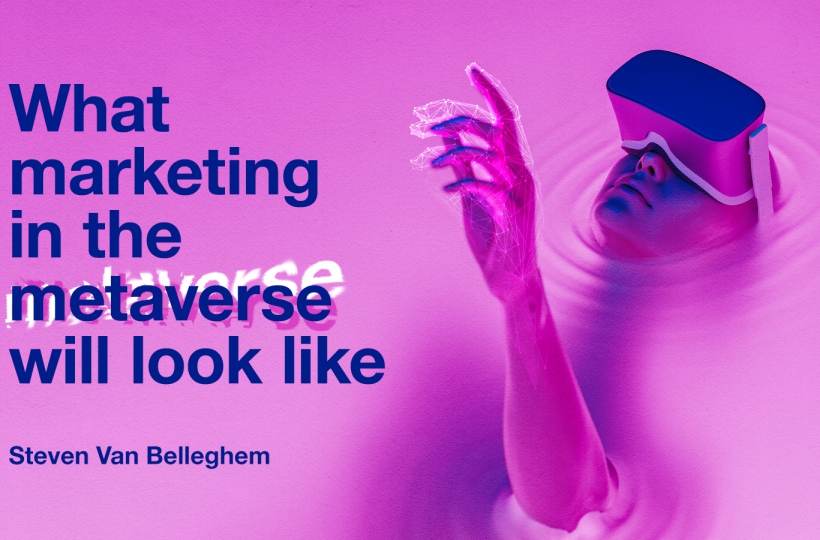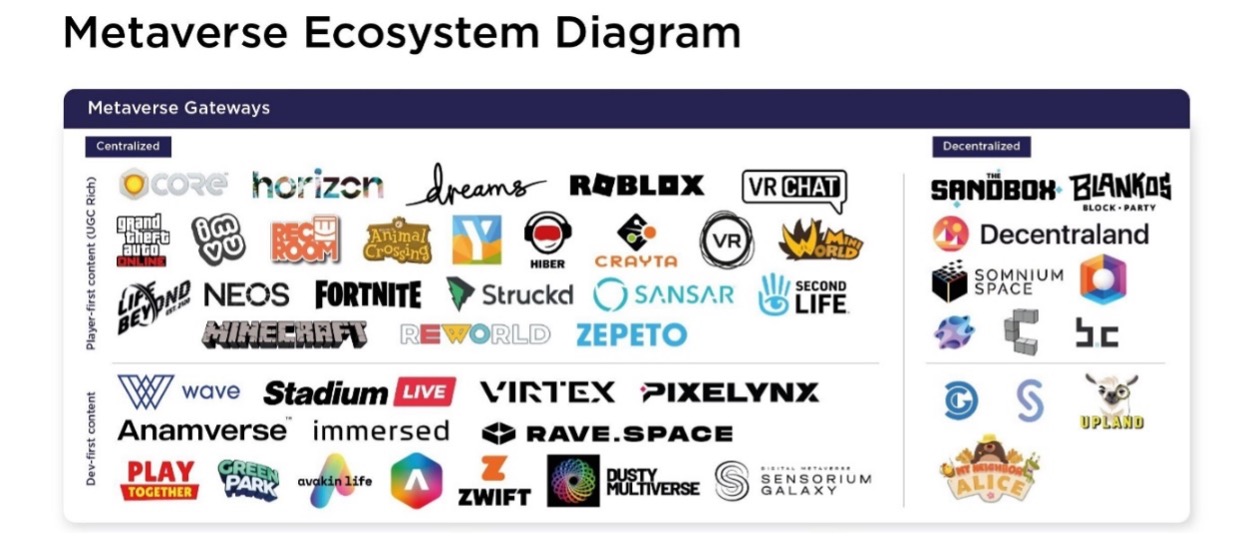What marketing in the metaverse will look like

A world of possibilities
Above all, the hefty debate around the metaverse shows that we find ourselves in a very seminal phase, at a new frontier. Where few people really understand what it is or where it is going. And where a limited group of first movers is experimenting to understand it. I believe that this is the perfect moment for companies to start testing it in terms of marketing and CX: the potential is huge and the entry costs still rather low (depending on what you choose to do there, obviously).
Just to give an example of the potential audience you could reach: in 2019 10.7 million people attended Marshmello’s Fortnite concert. Back then, we thought that was huge. About a year later, Travis Scott’s Fortnite event reached 45.8 million people. And as you can see: the amount of VR and AR users (in the US) keeps steadily growing:
Where is the metaverse?
The metaverse has been around for quite a while now, especially in gaming. Names you will probably have heard are those of (game) metaverses Roblox, Fortnite, Minecraft, Animal Crossing and VR Chat. And of course some big tech companies like Meta – with Horizon – and Microsoft – which recently acquired game developing company Activision for developing its own Metaverse – are heavily investing in this area as well. And those are just the centralized versions. The decentralized ones like The Sandbox and Decentraland are where it gets really interesting: they run on the blockchain and are thus also part of the Web3 phenomenon.
I don’t want to get to technical here, but a very short detour, for those of you who are not familiar with Web3: it’s an idea for a new version of the World Wide Web based on the blockchain. The latter is decentralized, shifts data ownership back to the users and thus offers a lot more data privacy and security. This approach would also lessen the power of the big tech giants and offer it back to the users themselves. The metaverse and Web3 are by no means synonyms, but some metaverse platforms – the decentralized ones – are a part of Web3.
Also, some believe that at one point, all metaverses should, and will, evolve towards the Web3 paradigm. To give an example: even Meta is investigating the benefits of blockchain for its own Horizon suite.
Image source: Newzoo: Introduction to the Metaverse Report
Metaverse marketing
So how can brands profit from the opportunities of the metaverse today? How can you experiment with it in ways that can benefit your brand, image, customer experience and even make a profit from it? For now, I see 6 main ways surfacing, when I look at what top brands like Balenciaga, Coca Cola or Puma seem to be doing there:
- Advertisement
- Virtual Influencers
- Advergames
- Virtual Venues
- Virtual Events
- Metaverse commerce
Before we dive deeper into all of them, a caveat: just like with any marketing endeavour, it’s important to draw up a strategy with clear objectives first. How could you use the metaverse to offer a better experience to your existing customers? Or how can you create awesome experiences for e whole new type of customers? How can it reinforce your brand? Or how could you even disrupt it, with clever innovation approaches? Ask yourself a lot of questions, be critical but also look really hard for opportunities. Don’t just “do something in the metaverse”. Just like with the more traditional channels, that will obviously not work, unless you get very lucky.
1. Advertisement
So, advertisement in the metaverse. This is perhaps one of the less exciting opportunities since it’s about using old school methods in a new environment. The pro is that this shift from digital advertising to metaverse marketing allows brands to tap into a pretty massive audience, often at a more affordable price than through the traditional channels. The drawback is that it’s not a great match for the disruptive environment that the metaverse is (and will become).
But, to be fair, quite a few brands are looking into this. In 2021 Dimension Studio – which creates virtual worlds and humans for the metaverse – gathered $6.5 million in revenue from making metaverse technology for fashion brands, including tools to create virtual advertisements.
To give some examples: Coca-Cola, Samsung, and Volkswagen have invested in virtual billboards within video games like Football Manager and Hyper Scape. This is the type of service that Bidstack, a video game ad tech company, offers: it actually transitioned from working in real-world outdoor advertising to placing ads on virtual billboards. Recently, metaverse game Roblox began experimenting with interactive ads as well.
But it’s not just about virtual billboards and graphical banners, some artists cleverly used audio ads as well. Nas, for example, used in-game audio ads to promote his album “King’s Disease II.” It saw a 1,275% click-through rate relative to the typical rate of traditional in-game banners.
2. Virtual Influencers
Another slightly “old school” marketing approach in the metaverse is by using influencers, but ones that are virtual. This approach has quite a few advantages compared with real influencers, seeing that the latter are a lot more expensive and a lot less controllable.
Daisy, for instance, is a virtual influencer created for online luxury discount site Yoox. She was featured in multi-brand campaigns, wearing clothes by Calvin Klein and Tommy Hilfiger. Puma also used a virtual influencer – Maya – for its campaigns in South East Asia.
Other brands have a slightly different approach, by using avatars which are modelled on real people. Dior created a digital doppelganger of the Chinese actress Angelababy to attend its pre-fall show in Shanghai. Similarly, a digital double of supermodels Naomi Campbell and Kendall Jenner starred in Burberry’s TB summer monogram collections.
3. Advergames
A more interesting approach is how brands are creating advergames: an advertising technique where games are used as a means of advertising products or services. So, the brands do not advertise in the games of other parties, but they design their very own games.
Tourism New Zealand, for instance, launched PLAY NZ, a 3D world-style adventure gaming experience, developed by TBWASydney. The game lets people explore some of New Zealand’s greatest sites and attractions in a completely new way. Luxury brand Balenciaga introduced video game “Afterworld: The Age of Tomorrow” where the users enter a virtual Balenciaga store and experience Balenciaga’s fall collection. Louis Vuitton has “Louis The Game”, a video game that combines its heritage, innovation, and NFT art.
4. Virtual Venues
One step further in metaverse marketing is when brands like Warner Bros., Hyundai, Adidas and Gucci are effectively claiming virtual real estate in the metaverse with their own virtual venues.
DBS bank recreated Singapore’s iconic Zouk night club in Fortnite, renaming it the ‘Live Fresh Club’ to advertise its credit card of the same name. Verizon brought the Super Bowl stadium to Fortnite, giving players the chance to meet avatars of NFL players. Sotheby’s recently announced its own metaverse gallery for curated virtual art, housed in Decentraland. Christie’s took it one step further, with a showcase and a sales venue for digital art — from NFT artworks to Old Masters — but notably it is also a meeting place. Hyundai Motors launched five theme parks on Roblox to introduce younger consumers to Hyundai’s products and future mobility solutions.
American exercise equipment and media brand Peloton, then, allows its customers to ride physical bicycles to digital instruction from people in virtual gyms. Vans launched a virtual skatepark in Roblox that lets players try new tricks, and they can earn points to redeem in the virtual store to customize their avatar. Warner Music Group (WMG) is partnering with the decentralized gaming company Sandbox to create the first music-themed world in The Sandbox gaming metaverse: a combination of musical theme park and concert venue, which will feature concerts and musical experiences from WMG artists.
5. Virtual Events
This is an approach mostly leveraged by the entertainment industry, but the attendance numbers are pretty impressive and well worth our attention: 2.3M people watched Travis Scott’s concert on Fortnite, 33M people saw the Lil Nas X concert on Roblox, 500,000 watched the Bigger Love virtual John Legend show. All attendance numbers that are much higher than in real life.
Fortnite X Star Wars, then, was an event within Epic Games’ Battle Royale game, Fortnite, to promote Star Wars: Episode IX The Rise of Skywalker. And In December, Tencent Music Entertainment Group (TME) announced that it will officially launch TMELAND, where visitors can attend virtual concerts, do virtual livestream, visit the music museum with friends or playing games.
But corporates, too, are increasingly understanding the value of virtual events for their customer experience. Lindsey McInerney, Global Technology and Innovation Director at Anheuser-Busch InBev believes that “The future of sports, media, and entertainment is virtual. Almost 2.5 billion people are already participating in the virtual economy. This is the direction of the world’s evolution.”
6. Metaverse commerce
But perhaps the most interesting opportunity in marketing and CX in the metaverse is what I like to call metaverse commerce (it was one of my top trends for the next years in this popular piece). It’s also called the direct-to-avatar (D2A) economy, where brands are starting to sell digital goods inside the metaverse.
It’s not a brand new phenomenon, seeing that for instance in-game commerce has been around for quite a while now and the in-game purchase market value is even projected to evolve to $74.4 billion by 2025. But we’ve recently really seen a fast uptake of (corporate) brands like Clinique, Tencent, Anheuser-Busch and Gucci in all types of metaverse environments.
A very visible part of this is of course the non-fungible token or NFT market, whereby virtual goods are turned into unique content and collectibles or where a smart contract is added into the mix. In the Metaverse, these non-fungible tokens enable virtual ownership of the asset. Visitors of the Gucci Garden virtual store can for instance purchase exclusive, limited-edition avatar items. It has for instance sold a digital bag on Roblox for $4,000. Coca Cola launched virtual wearable NFTs, including a wearable jacket in the Decentraland metaverse. Samsung, then, gave away rare avatar clothing — a racing jacket, helmet and shoes – as NFTs.
But it’s not just about these ‘unique’ NFTs. Brands are also selling ‘regular’ virtual products in the metaverse. Balenciaga has partnered with Fortnite to design virtual outfits, accessories, and weapons that players can purchase for their avatars. The Gucci Virtual 25 – a digital pair of sneakers – can be bought for between $9 and $12 to be ‘worn’ in augmented reality or used in partnered apps like Roblox and VRChat. Nike bought a virtual shoe company that makes sneakers ‘for the metaverse’ and even has a dedicated Director of Metaverse Engineering: Andrew Schwartz.
That’s it for now. Seeing that these are still the very early days of the metaverse, I’m sure that many other marketing and CX use cases – which we haven’t thought of yet today – will surface along the way. I, personally, am very excited about this area, including that of NFTs and the broader Web3 trend (which is why I’m organizing a Web3 tour in May in London, together with my nexxworks Partner Peter Hinssen.) and will be keeping an eye out for how all of these trends evolve. I hope that you will do the same.

